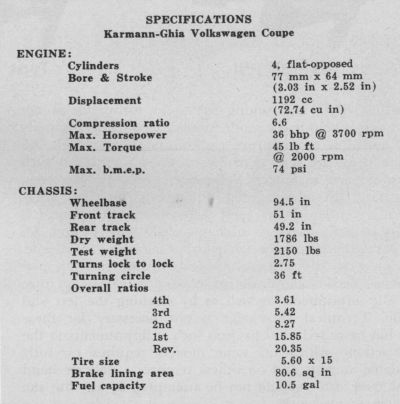April 1956 Sports Cars Illustrated
| SCI
Tests the new KARMANN GHIA Volkswagen by Karl Ludvigsen |
 Interior is luxurious and roomy compared to the standard model |
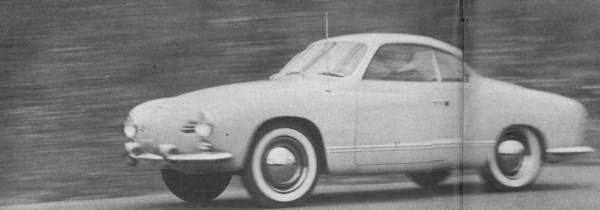
New VW has the looks and handling qualities of a sports car but not the speed nor the
acceleration characteristics. Top speed: 60 mpg.
|
THE “word” on the
Volkswagen has long been: “It’s a great
car, if you don’t mind the way it looks.” Even the most devoted
salesman will
admit that the standard car doesn’t exactly appeal to the womenfolk. No
one has
been more aware of this, of course, than the manufacturer, and a
calculated
step is being taken to relieve the situation. Surprisingly, the
proposed
solution only seems to have made matters more critical. |
|

The rear seat of the new car is versatile. Room is available underneath for carrying tools and other small items.
The seat itself s large enough for adults on short trips.
Folded flat as in a station wagon, room is provided for luggage or sleeping children.
|
The preceding
paragraphs have in part answered the “sport
car?” question, but it might be interesting to leave the matter open
while we
look over this svelte version of our old friend. Whether or not it is a
good
thing, the Karmann Ghia looks like a sports car. Its clean lines need
no chrome
emphasis, and the slim top is very well done. Construction is
all-steel, with
the fenders firmly welded to the main body. The Karmann shell is bolted
to a
slightly wider than standard Volkswagen backbone-reinforced platform
frame.
;The front and rear deck lids fit neatly, and, when opened by interior
pull-knobs, they are supported by counterbalancing springs. One
middle-sized
suitcase would go in the front “trunk,” and there is additional room in
the
nose bulge forward of the vertically-placed spare tire. Accessory
makers will
probably soon supply a lining to make this space usable without
interfering
with the horns placed there. |
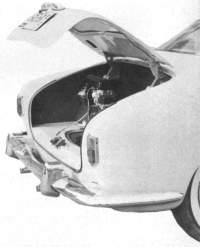
Abrupt drop in rear deck lid interferes slightly with routine checks but not overly so. Lid is held open by tension hinges. |
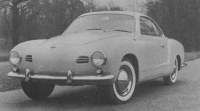 High “hood” line make for slightly less forward visibility than is the case with slant-nosed Porsche or standard VW. 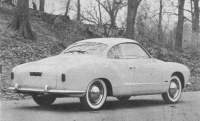 Clean lines of the car indicate the Ghia design influence on otherwise strictly Teutonic Volkswagen. 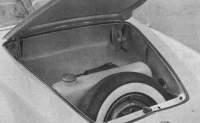 As in both VW and Porsche, the forward compartment houses spare tire and fuel tank with little spare room. |
Increase in
tire pressure almost invariably brings an increase in cornering power,
so this
counts as another measure to make the notorious VW back end stick in a
turn as
long as the front end. Purely an added dividend is the much lower
center of
gravity of the new car, which, with the same suspension, should reduce
the roll
moment and thus, the resulting roll angle. 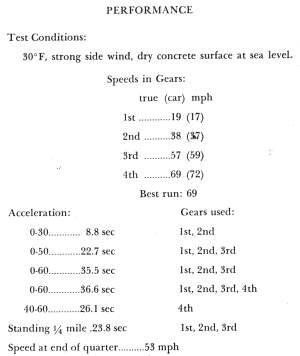 |
|
As usual, I then
tried the car with
pressures increased all
around by six pounds. With this help, it handled very well indeed. Roll
was
reduced and the tires were dead quiet, the Karmann-Ghia slicing neatly
around
on a neutral line. Rather higher speeds were also obtainable before the
antics
at the back required attention, and there was an additional gain in
straight
line stability. Unexpectedly, the higher pressures didn’t seem to
affect the
ride much, the all-independent Volkswagen chassis seeming to depend
more on
suspension than tires. The short wheelbase produces a certain amount of
pitch,
and some bumps can be felt, but the ride is still better than that of
any
comparable car, except, perhaps, the Porsche. |
There remains some hope for the
top end
of the range, where the lower frontal area of the coupe may help out.
This is
not a wind tunnel job, though, and the regular VW is pretty clean, so
miracles
are not likely. Getting into action, the flat four
starts quickly from cold
and similarly when warm if an understanding throttle foot is used.
Idling is
regular enough but not smooth in a mechanical sense, the engine already
showing
its desire to run fast. Low speed response to the throttle is sluggish,
probably due in part to the long inlet pipes. Again, it jumps much more
quickly
at higher speeds, where the engine smoothes out and feels at home. When
accelerating it emits a purposeful rumble, and seems to make less
thrashing
noise than the standard car. The only marked flat spot in the speed
range comes
just after a leisurely shift from second to third. Actual acceleration figures are about
what could be expected
of a brand new car, ranging as they do from a little slower than
standard at
low speeds to better than par at the top end. Terminal velocity is
three or
four miles higher than the VW, and half a second is lopped off the
standing
quarter. In spite of these improvements, the data are not outstanding
on an
absolute basis, and the Karmann-Ghia has revealed itself as a car that
makes
searching demands on its gearbox ratios. These, fortunately, are well
spaced,
second and third being very useful in reaching a speed which the
overdrive top
gear can maintain. |
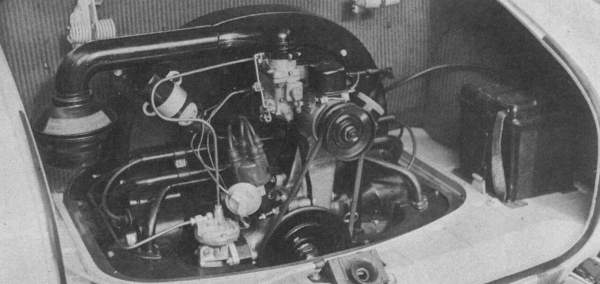
Only change in
the engine is the use of the Transporter air
cleaner layout and a #195 air correction jet.

Suspension
improvements have been made to increase the road
holding.
The ‘main change is the use of a torsion anti-roll bar to connect the
front trailing arms (left).
The rear suspension (center) is similar to standard
VW. Frame is beefed up (right).
|
The spindly shift
lever has a long longitudinal and short
lateral travel, a push-down latch-out being provided for reverse.
Shifting
“feel” is adequate but not direct. The Borg- Warner synchromesh on the
top
three speeds is foolproof, the lightness of the gears helping to make
shifts
nearly instantaneously. If this is done under full throttle, though,
the clutch
will slip rather than grab. This is to be expected of an otherwise
perfectly
smooth touring unit, which heated up and tended to judder slightly
after the
acceleration runs. |
Instruments are
large and clearly marked, that job on the
right being a very accurate electric clock and not a 12,000 rpm
tachometer. The
speedometer, reading to 90 instead of the standard 80, is festooned
with
warning lights for oil pressure, charging rate, bright headlights, and
the self-cancelling
directional signals. Both dials are readily visible through the wheel,
and are
flanked on one side by the choke and twist-to-start ignition, and by
the light
control and switch for the self-parking windshield wiper on the other.
Very
good instrument light is supplied, but cannot be used because it is
reflected
on the windshield directly in the line of vision — another opportunity
for a
suitable accessory. The glove box is wide and deep, with an awkward
push-to-open catch, and it is supplemented by map pockets in the doors. |
